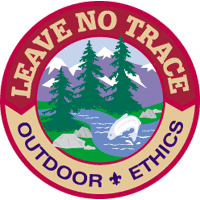 Leave No Trace Leave No Trace
The tremendous rewards of high-adventure treks
are drawing more and more people to the backcountry. At the same time,
the vast territory suitable for treks is shrinking in size. More
people and less land mean we all must be careful not to endanger the
wild outdoors we have come to enjoy.
A High-Adventure Ethic
A good way to protect the backcountry is to
remember that while you are there, you are a visitor. When you visit a
friend you are always careful to leave that person's home just as you
found it. You would never think of dropping litter on the carpet,
chopping down trees in the yard, putting soap in the drinking water,
or marking your name on the living room wall. When you visit the
backcountry, the same courtesies apply. Leave everything just as you
found it.
Hiking and camping without a trace are signs
of an expert outdoorsman, and of a Scout or Scouter who cares for the
environment. Travel lightly on the land.
The Principles of "Leave
No Trace"
"Leave No Trace" is a nationally
recognized outdoor skills and ethics education program. The Boy Scouts
of America is committed to this program. The principles of Leave No
Trace are not rules; they are guidelines to follow at all times.
The Leave No Trace principles might not seem
important at first glance, but their value is apparent when
considering the combined effects of millions of outdoor visitors. One
poorly located campsite or campfire is of little significance, but
thousands of such instances seriously degrade the outdoor experience
for all. Leaving no trace is everyone's responsibility.
Plan Ahead and Prepare
Proper trip planning and preparation helps
hikers and campers accomplish trip goals safely and enjoyably while
minimizing damage to natural and cultural resources. Campers who plan
ahead can avoid unexpected situations, and minimize their impact by
complying with area regulations such as observing limitations on group
size.
Proper planning ensures
- Low-risk adventures because campers
obtained information concerning geography and weather and
prepared accordingly
- Properly located campsites because
campers allotted enough time to reach their destination
- Appropriate campfires and minimal trash
because of careful meal planning and food repackaging and proper
equipment
- Comfortable and fun camping and hiking
experiences because the outing matches the skill level of the
participants
Camp and Travel on Durable
Surfaces
Damage to land occurs when visitors trample
vegetation or communities of organisms beyond recovery. The resulting
barren areas develop into undesirable trails, campsites, and soil
erosion.
Concentrate Activity, or Spread
Out?
- In high-use areas, campers should
concentrate their activities where vegetation is already absent.
Minimize resource damage by using existing trails and selecting
designated or existing campsites.
- In more remote, less-traveled areas,
campers should generally spread out. When hiking, take different
paths to avoid creating new trails that cause erosion. When
camping, disperse tents and cooking activities-and move camp daily
to avoid creating permanent-looking campsites. Always choose the
most durable surfaces available: rock, gravel, dry grasses, or
snow.
These guidelines apply to most alpine settings
and may be different for other areas, such as deserts. Learn the Leave
No Trace techniques for your crew's specific activity or destination.
Check with land managers to be sure of the proper technique.
Pack It In, Pack It Out
This simple yet effective saying motivates
backcountry visitors to take their trash home with them. It makes
sense to carry out of the backcountry the extra materials taken there
by your group or others. Minimize the need to pack out food scraps by
carefully planning meals. Accept the challenge of packing out
everything you bring.
Sanitation
Backcountry users create body waste and
wastewater that require proper disposal.
Wastewater. Help prevent contamination of
natural water sources: After straining food particles, properly
dispose of dishwater by dispersing at least 200 feet (about 80 to 100
strides for a youth) from springs, streams, and lakes. Use
biodegradable soap 200 feet or more from any water source.
Human Waste. Proper human waste disposal helps
prevent the spread of disease and exposure to others. Catholes 6 to 8
inches deep and 200 feet from water, trails, and campsites are often
the easiest and most practical way to dispose of feces.
Leave What You Find
Allow others a sense of discovery: Leave
rocks, plants, animals, archaeological artifacts, and other objects as
you find them. It may be illegal to remove artifacts.
Minimize Site Alterations
Do not dig tent trenches or build lean-tos,
tables, or chairs. Never hammer nails into trees, hack at trees with
hatchets or saws, or drainage bark and roots by tying horses to trees
for extended periods. Replace surface rocks or twigs that you cleared
from the campsite. On high-impact sites, clean the area and dismantle
inappropriate user-built facilities such as multiple fire rings and
log seats or tables.
Good campsites are found, not made. Avoid
altering a site, digging trenches, or building structures.
Minimize Campfire Use
Some people would not think of camping without
a campfire. Yet the naturalness of many areas has been degraded by
overuse of fires and increasing demand for firewood.
Lightweight camp stoves make low-impact
camping possible by encouraging a shift away from fires. Stoves are
fast, eliminate the need for firewood, and make cleanup after meals
easier. After dinner, enjoy a candle lantern instead of a fire.
If you build a fire, the most important
consideration is the potential for resource damage. Whenever possible,
use an existing campfire ring in a well-placed campsite. Choose not to
have a fire in areas where wood is scarce-at higher elevations, in
heavily used areas with a limited wood supply, or in desert settings.
True Leave No Trace fires are small. Use dead
and downed wood no larger than an adult's wrist. When possible, burn
all wood to ash and remove all unburned trash and food from the fire
ring. If a site has two or more fire rings, you may dismantle all but
one and scatter the materials in the surrounding area. Be certain all
wood and campfire debris is dead out.
Respect Wildlife
Quick movements and loud noises are stressful
to animals. Considerate campers practice these safety methods:
- Observe wildlife from afar to avoid
disturbing them.
- Give animals a wide berth, especially
during breeding, nesting, and birthing seasons.
- Store food securely and keep garbage and
food scraps away from animals so they will not acquire bad
habits. Help keep wildlife wild.
You are too close if an animal alters its
normal activities.
"Leave No Trace"
Information
For additional Leave No Trace information,
contact your local land manager or local office of the Bureau of Land
Management, the Forest Service, the National Park Service, or the Fish
and Wildlife Service. Or, contact Leave No Trace at 800-332-4100 or on
the Internet at http://www.lnt.org.
For posters, plastic cards listing the Leave
No Trace principles, or information on becoming a Leave No Trace
sponsor, contact Leave No Trace Inc., P.O. Box 997, Boulder, CO 80306,
phone 303-442-8222.
Respect Others
Thoughtful campers
- Travel and camp in small groups (no more
than the group size prescribed by land managers).
- Keep the noise down and leave their
radios, tape players, and pets at home.
- Select campsites away from other groups
to help preserve their solitude.
- Always travel and camp quietly to avoid
disturbing other visitors.
- Make sure the colors of their clothing
and gear blend with the environment.
- Respect private property and leave gates
(open or closed) as found.
Be considerate of other campers and respect
their privacy.
Master of Leave No Trace
Training Course
Master of Leave No Trace training courses are
available from the National Outdoor Leadership School (NOLS) in
cooperation with four federal agencies (the Bureau of Land Management,
Forest Service, National Park Service, and Fish and Wildlife Service).
Approximately 18 courses are taught throughout the country each year
in all types of environments from alpine tundra to deserts.
The Master of Leave No Trace course has three
components:
- low-impact camping skills,
- wild-land ethics, and
- teaching techniques.
A five-day field course provides students with
a comprehensive overview of Leave No Trace techniques through
practical application in a field setting comprising a short
backcountry trip.
If you are interested in attending a Master of
Leave No Trace course, call the Leave No Trace hotline at 800-332-4100
ext. 282. Also call that number for a list of Leave No Trace masters
in your area.
|
![]() Full Word
Document Version of BSA Application and Requirements
Full Word
Document Version of BSA Application and Requirements
.jpg)

 Leave No Trace
Leave No Trace